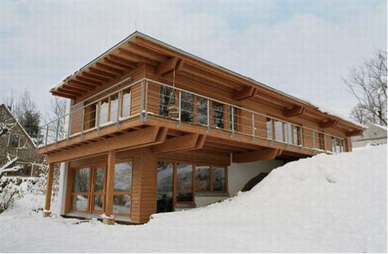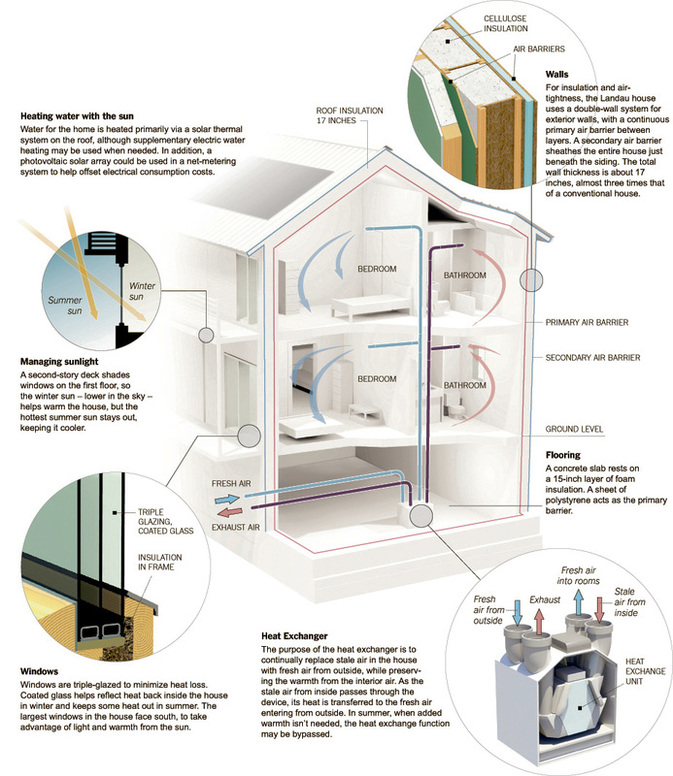
Have you heard of passive homes?
They are super ultra energy-efficient homes.
In the clean tech world, there is nothing cleaner than a Kwh, or Btu that is not used. At today’s U.S. electricity consumption, you’d have to cover the equivalent of the entire state of Michigan with solar panels to meet the country current electricity needs, and that would still not cover for the hours where the sun is not shining.
Forty percent of electricity use in the United States comes from residential homes; add to that 35% from commercial buildings, if we were to make all of our residential homes and commercial buildings “passive,” we could cut out 2/3rd of the U.S. electricity consumption! Yes, the claim is that a well-designed passive home can reduce energy consumption by 90%.
The concept of a passive home is not new. But, earlier passive houses have been known to trap moisture inside, leading to mold and indoor air quality issues. More advanced designs and ventilation systems would eliminate these problems.
The New York Times has a very nice graphic explaining how these homes work: very thick walls, well-oriented windows, and underground heat exchangers. See below.
Now the question is what would trigger U.S. consumers to retrofit their homes to be ultra energy efficient/passive? With the vast supply of newly found natural gas in the form of shale gas, the powerful and well-capitalized oil and gas companies are investing to drill any shale gas they can locate, which is bound to keep electricity and natural gas prices at an all time low for the foreseeable future. Thus, paying your monthly electricity and gas bill will be cheaper than the capital expenditure you’d have to make to retrofit your home.
For now, the passive home might only be for the wealthy and environmental friendly consumer.
~~~~~~~~~~~~~~~~~~~~~~~~~~~~~~~~~~~~~~~~~~~~~~~~~~~~~~~~~~~~~~~~~~
The Secrets of a Passive House
The New York Times
09/25/2010
When completed, the Landau residence now under construction in Norwich, Vt., will be one of about a dozen buildings certified as “passive houses” in the United States. Their strict building standard sets limits on total energy consumption and peak heating and cooling demand. A heat exchanger circulates fresh air throughout the house and reuses warmth from the inside air. The result is a house that typically uses 90 percent less energy for heating than a conventional house.
Read full article here
They are super ultra energy-efficient homes.
In the clean tech world, there is nothing cleaner than a Kwh, or Btu that is not used. At today’s U.S. electricity consumption, you’d have to cover the equivalent of the entire state of Michigan with solar panels to meet the country current electricity needs, and that would still not cover for the hours where the sun is not shining.
Forty percent of electricity use in the United States comes from residential homes; add to that 35% from commercial buildings, if we were to make all of our residential homes and commercial buildings “passive,” we could cut out 2/3rd of the U.S. electricity consumption! Yes, the claim is that a well-designed passive home can reduce energy consumption by 90%.
The concept of a passive home is not new. But, earlier passive houses have been known to trap moisture inside, leading to mold and indoor air quality issues. More advanced designs and ventilation systems would eliminate these problems.
The New York Times has a very nice graphic explaining how these homes work: very thick walls, well-oriented windows, and underground heat exchangers. See below.
Now the question is what would trigger U.S. consumers to retrofit their homes to be ultra energy efficient/passive? With the vast supply of newly found natural gas in the form of shale gas, the powerful and well-capitalized oil and gas companies are investing to drill any shale gas they can locate, which is bound to keep electricity and natural gas prices at an all time low for the foreseeable future. Thus, paying your monthly electricity and gas bill will be cheaper than the capital expenditure you’d have to make to retrofit your home.
For now, the passive home might only be for the wealthy and environmental friendly consumer.
~~~~~~~~~~~~~~~~~~~~~~~~~~~~~~~~~~~~~~~~~~~~~~~~~~~~~~~~~~~~~~~~~~
The Secrets of a Passive House
The New York Times
09/25/2010
When completed, the Landau residence now under construction in Norwich, Vt., will be one of about a dozen buildings certified as “passive houses” in the United States. Their strict building standard sets limits on total energy consumption and peak heating and cooling demand. A heat exchanger circulates fresh air throughout the house and reuses warmth from the inside air. The result is a house that typically uses 90 percent less energy for heating than a conventional house.
Read full article here


 RSS Feed
RSS Feed